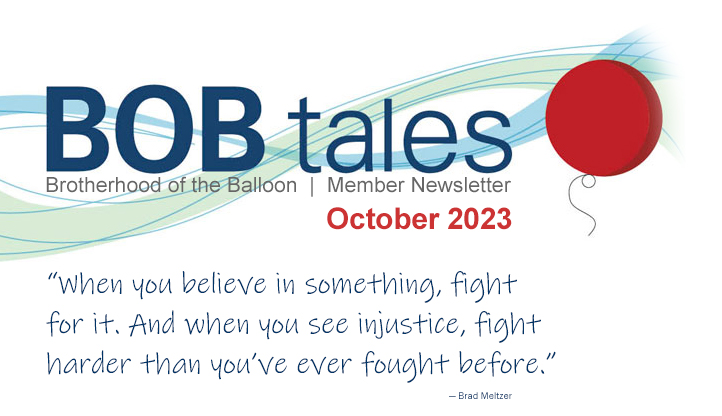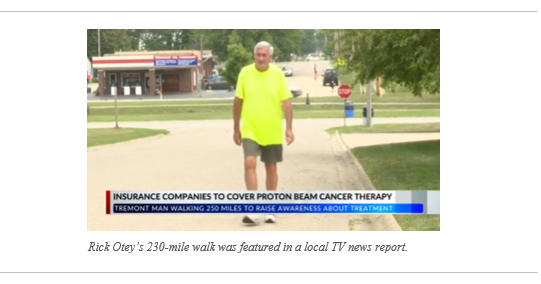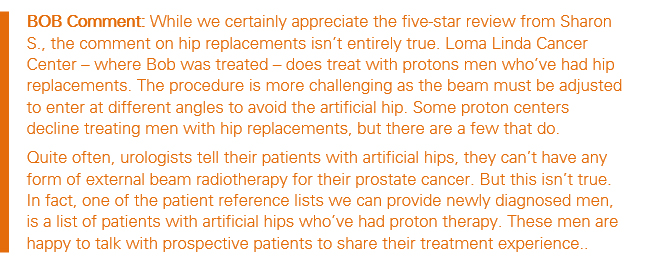
Dear Members (a note from Deb Hickey):
No Veteran – especially a Vietnam Vet who was recently diagnosed with prostate cancer – should have to call a Senator, two Congresswomen, a private investigator, and the president of the United States to access the cancer treatment that will give him the best outcome.
A man who set aside his fears; left his family, friends and all the comforts of home; and put his life at risk to protect his country should be able to easily access the treatment that will not only save his life, but also give him the quality of life he deserves.
But instead, because of where he lives, he’s denied treatment. Not to mention that prostate cancer is one of the conditions any Vietnam Vet may have acquired due to Agent Orange exposure. It should be a slam dunk for insurance approval!
Respected Veteran and BOB member Robb Woodworth did his due diligence and found his way to proton therapy. When he was denied health insurance coverage, he decided to fight back. And he’s still fighting. Read Robb’s story in this month’s “Member Spotlight” section.
Robb isn’t the only one fighting for change within the VA. Jennifer Maggiore, executive director of the National Association for Proton Therapy, recently sent a letter to the National Director of Radiation Oncology at the VA to push for an updated healthcare policy to ensure Vets have equitable access to proton therapy. And if you know Jennifer, you know she won’t quit until change happens.
We also have another valiant proton warrior in our group, Sen. Bill Hansell, who recently achieved victory for the state of Oregon and proton therapy. Read his story in our "News Report" section.
Also in this issue – read about a man whose uncle and father had prostate cancer, but was never advised by his doctor to get tested for the disease. He was later diagnosed with stage-four cancer. Our Flashback article on male osteoporosis is the first in a very important four-part series written by a prominent and learned member of our group.
This month, we also write about one of our members who walked 230 miles around a local park to raise awareness about proton therapy. In our Health section, we report on a new study on the benefits of exercise after receiving a cancer diagnosis, and we write about 14 foods that’ll give you energy (a few of them surprised me). And as always, there’s a lot more.
We love to get feedback on the newsletter and welcome any suggestions you have on how to improve the value of the BOB Tales to our members. Please send an email to [email protected].
Deb Hickey
*To print the BOB Tales newsletter or view the newsletter with a larger font size, click here for the PDF file.

- When Screening for Prostate Cancer Comes Too Late
- Big Win for Proton Therapy and Prostate Cancer Patients in Oregon
- NAPT Fights for Vets
- Male Osteoporosis: A Four-Part Series - Part I
- Vet Fights for Access to Protons
- BOB Member Walked 230 Miles for Proton Therapy
- New Study: Exercise Improves Survival After a Cancer Diagnosis
- 14 Foods That Give You Energy
When Screening for Prostate Cancer Comes Too Late
David Weigand’s uncle had prostate cancer, and his father died from it. Yet widely followed recommendations from the U.S. Preventative Services Task Force (USPSTF) didn’t consider David eligible for a PSA test because he was under 55-years-old.
If you have a parent or sibling with prostate cancer, your risk of developing the disease is two to three times greater than average. The risk increases further with the number of relatives diagnosed. Nobody had explained this to David.
At age 53, David asked his doctor for a PSA test only at the urging of his partner. But it was already too late to catch the disease early. David’s PSA levels were quite elevated. After a biopsy, he was diagnosed with stage-four cancer that had spread to lymph nodes in his pelvis.
“My prostate was completely covered in cancer,” David said. “The situation that I’m in was so preventable.”
David underwent surgery and started a new drug in addition to hormonal therapy. He also started a plant-based diet and elevated his exercise routine.
“I can’t help but think how incredible it is that an easy blood test can help men catch this earlier,” David said. “I would not be fighting as I am for my life.”
High-risk Men Getting Lost
The debate about prostate cancer screening has lasted decades. PSA testing in the 1990s led to overtreatment and damaging side effects for many men. Doctors scaled back after the USPSTF recommended against PSA-based screening for prostate cancer for men of all ages in 2012. About five years later, the task force changed their position slightly, recommending that 55-69-year-old men speak with their doctors about the advisability of getting a PSA test.
The problem – many men are still getting diagnosed with prostate cancer at later stages, when it may be too late to be cured. The risk of dying from prostate cancer has been relatively flat in recent years. The cause for this slowing progress is most likely related to the USPSTF’s screening guidelines. Some worry deaths could rise in coming years.
Groups including the American Cancer Society are reviewing their own guidance for prostate cancer screening. One idea is to target certain high-risk groups – like black men or those with a family history of the disease – and encourage them to get tested earlier.
“PSA recommendations have been ping-ponging back and forth, and what’s been lost in that is the high-risk people,” said Dr. Heather Cheng, director of the Prostate Cancer Genetics Clinic at Fred Hutchinson Cancer Center in Seattle.
Cheng, along with other doctors, are reviewing the American Cancer Society’s prostate cancer screening guidelines. They’re working to better regulate screening so that doctors monitor low-risk tumors for growth rather than rush men into treatment. Better imaging tools have helped with this effort.
Big Win for Proton Therapy and Prostate Cancer Patients in Oregon

Sen. Bill Hansell was treated with proton therapy at Loma Linda in late 2000. That’s where Bob Marckini first met him, and they became good friends. Bill has been an unapologetic cheerleader for proton therapy for nearly 23 years. It began with a series of articles he wrote for a local Oregon newspaper while he was in treatment. It continued over the years with Bill encouraging family members, friends, and acquaintances to consider proton therapy for prostate cancer treatment. He also put his money where is mouth is. As a prominent political figure in his state, Bill used his pulpit to fight for those being denied insurance coverage.
Bill will have 42 years of elected office when he retires in 2024 including 30 years as Umatilla County Commissioner and 12 years as a state senator. He and his wife, Margaret, have been married 56 years. They have six children and 11 grandchildren. Bill was one of the first six (charter) members of the Brotherhood of the Balloon.
Through Bill’s heroic efforts, hard work, and persistence, the state of Oregon requires insurers within the state to fund proton therapy at the level of other major treatment options in the state. The following article, written by Bill, describes the challenges he faced in bringing the medical insurers together and convincing his colleagues in the state House and Senate to support his legislation. It took several years, but he prevailed.
A Friend is Denied Coverage
“Bill, I’m so disappointed,” said my good friend Eric. “I traveled all the way to Loma Linda for my consultation and after being told I was a good candidate for proton beam, I learned that insurance companies in Oregon no longer cover proton therapy.”
I’d been referring Oregonians like Eric to Loma Linda University Cancer Center ever since I successfully completed my own proton beam treatment in the fall of 2000, and while many had been initially denied coverage, they eventually prevailed and won their appeals. Needless to say, I was concerned and angry, and decided to do something about it.
As a member of the Oregon Senate, I decided to go to battle for this treatment. Why were Oregon men suddenly being denied coverage for proton beam treatment? I made it one of my legislative priorities for the 2019 Legislative Session. Little did I know I’d soon feel like David taking on Goliath over the next six years. I kept reminding myself who won that battle! It just took me a little longer than David to get the job done.
Meeting with Lobbyists
I knew, of course, insurers were resisting because of the higher cost of proton therapy. As my legislation was being drafted, I invited all the lobbyists for insurance companies doing business in Oregon to meet in my Capitol office. I laid out my position with them, making four important points.
First, this was very personal for me. I was diagnosed with prostate cancer in 2000; I had to battle my insurance company through multiple denials and appeals before approval was finally given; and I was cured of cancer with none of the serious side effects associated with surgery or conventional radiation.
Second, it was just plain wrong that after a couple of decades of approving proton therapy for Oregon men, that coverage suddenly stopped.
Third, I understood that proton therapy is more expensive, and I didn’t want to place a funding mandate on insurance companies doing business in Oregon. I wanted to work collaboratively, and that’s why I called the meeting.
Fourth, my proposed legislation was to make proton therapy available to Oregonians, without significant additional cost to the insurance companies. I proposed that they reimburse proton therapy at the current cost of surgery or conventional radiation, with the patient or their supplemental insurance making up the remainder of the cost. I also hoped that the proton centers would show some flexibility in their pricing schedules as well. My friend Eric had told me he could afford some of the out-of-pocket cost for proton therapy, but not the entire amount.
The meeting ended with all of us pledging to work together. Senate Bill 740 (SB740) was introduced, and we were off and running. The bill made sense, provided an option, that for the most part, had 100 percent support of the insurance companies. SB740 passed out of the Senate Health Care Committee and off the Senate Floor unanimously. On to the House of Representatives.
An Amendment Derails the Process
Then things suddenly changed. It was a different chamber with different legislators. Then some of the insurance companies decided they no longer supported the bill. An amendment, I was told, was needed to keep the insurance companies from opposing the bill, and most likely killing it. When I asked why this wasn’t brought up in the Senate hearings, I was told SB470 had been sent to “headquarters” for review only after it had passed the Senate. Some executives at headquarters decided an amendment was needed, but it wouldn’t really change the intent or impact of the bill.
Again, with the assurance that nothing would really change, and with time running out in the session calendar, I gave permission for the amendment to be drafted. The amended SB470 passed out of the House Health Committee, off the House floor, and was signed into law.
I was pleased. And there was great publicity. Oregon men like Eric would have some options for proton therapy. SB740 became law on Jan. 1, 2020. But, a few weeks later, my office began to receive calls that insurance companies were still denying coverage.
That’s when I realized the amendment had changed everything. It contained language that required “prior authorization.” The dial had been moved somewhat, but not as we’d intended. I lost the first round, but I didn’t give up. On to round two – the 2021 legislative session – this time a bit wiser.
One Final Attempt
We kept the same legislation, but with one major difference: the president of the Senate, Peter Courtney, asked if he could help. Together we co-sponsored SB2. This bill went through the Senate Health Committee and off the senate floor without opposition, and it didn’t include prior authorization.
This time I began to work with the House Health Chairman, Rachel Prusak, while SB2 was still working its way through the Senate. She was on board, but the House Health Committee was where SB2 ran into problems. There were some newly elected representatives, including a couple of doctors, who opposed the bill. Because of their influence, SB2 didn’t have the votes to get it out of committee, even with the chairman’s support. Chairman Prusak worked hard and with an amendment, we made some progress. It was better than what we had, but not what we really wanted. So, preauthorization stayed in, but with modifications. On to round three.
I knew going into the 2023 legislative session, there would be no round four. My wife Margaret and I had been discussing our future, and we decided that I wouldn’t run for reelection when my current four-year term ended at the end of 2024. I would make that announcement of the floor of the Senate in March.
Help from the Insurers and a Key State Representative
Before SB463 was drafted, two huge developments took place. First the insurance companies instructed their lobbyists to tell me they wouldn’t oppose proton therapy legislation as written in SB2 from the previous session, should I want to reintroduce it.
Second, newly elected state Rep. Hai Pham wanted to meet with me. His family fled Vietnam as refugees known as the “boat people.” He was a cancer survivor and a pediatric dentist. Hai had a bill dealing with some cancer issues, which I was in favor of, and he seemed interested in helping me with my bill. So, he became a co-sponsor for SB463. That was huge! Hai became a champion of the bill in the House. I hadn’t had that before!
This time when SB463 cleared the senate health and the senate floor with no opposition, I could hand it off to Hai. As a member of the Health Committee, Hai whipped up the votes and it cleared the committee with a nearly unanimous vote. I sat at his desk with him on the house floor when Hai carried SB463, with a 59 to 1 final vote.
What happened legislatively in Oregon was a bipartisan team effort, and I’m very grateful for that team. But I want to give a shoutout to another team – the Brotherhood of the Balloon, with members in the multiple thousands, all around the world. I was one of the original charter members of this marvelous group. This team has done so much for so many over the years. I’ve been inspired by the stories of other team members in helping others diagnosed with cancer. When I had the chance to do something in Oregon to make a difference, I took it, just like most of you have done in your communities. Thank you, Brotherhood of the Balloon team! Keep up the good work! There are still Goliaths to slay and men like Eric who need our help.
NAPT Fights for Vets
The National Association for Proton Therapy (NAPT) is pushing the Veteran’s Administration (VA) to make proton therapy more accessible to its members. NAPT Executive Director Jennifer Maggiore recently sent a letter to Dr. Michael Hagan, National Director of Radiation Oncology at the VA, urging him to recognize current research, including the updated proton policy released this year by the American Society for Therapeutic Radiology and Oncology (ASTRO). The 2023 policy clarifies and expands the types of conditions appropriate for treatment, and – with the inclusion of additional research – more accurately depicts the effectiveness of proton therapy.
Maggiore also believes that in light of the commitment the VA has made through its PACT act, this is a better time than ever to reevaluate proton therapy for Vets.
Following is an excerpt from Maggiore’s letter:

On behalf of the National Association for Proton Therapy (NAPT), I am writing to urge the Veterans Health Administration (VHA) to update its policy for coverage of proton beam therapy to ensure equitable access to this cutting-edge cancer treatment for our nation’s veterans given the favorable evolution in the body of evidence since the VHA last updated its policy…
Proton therapy is a radiation treatment modality that has the proven ability to reduce side effects for patients by limiting the amount of normal tissue exposed to radiation. Unlike conventional X-ray radiation, which has both entrance and exit doses, proton therapy delivers radiation to the target, with little to no radiation extending beyond the target. In addition to these acute and late toxicity benefits of proton therapy over conventional radiation therapy, proton beam therapy has been shown across multiple disease sites to improve overall survival, either by reducing life threatening toxicities, being more biologically potent at tumor killing, or allowing for more targeted and escalated doses of irradiation to be delivered directly to the tumor.
More than 900 publications have validated the efficacy of proton therapy – showing lower tumor recurrence rates, higher survival rates, fewer short-term and late toxicities, and better preservation of patient quality-of-life both during and after treatment. Over the years, there has been substantial evidence-based research demonstrating the effectiveness of proton beam therapy in treating various malignancies, leading to its acceptance as a critical component of comprehensive cancer care for many types of cancer. In light of the evidence base, the Centers for Medicare and Medicaid Services (CMS) affords Medicare beneficiaries with equitable access to proton therapy.
The VHA, as America’s largest integrated healthcare system, should also provide equitable access to advanced cancer treatments, like proton therapy, to provide the best outcomes for veterans with cancer. Unfortunately, many veterans, depending on the region where they are seeking care, are denied access to proton therapy. The VHA has been known to follow the 2017 American Society for Radiation Oncology (ASTRO) Model Policy for Proton Beam Therapy when authorizing requests for proton therapy. ASTRO recently updated its coverage guidelines in 2023, recognizing the current evidence-based research supporting the use of proton beam therapy for numerous types of cancer. This acknowledgment reinforces the favorable evolution of the evidence base and the importance of this treatment modality and further solidifies its position as a standard-of-care option for a number of cancer patients.
One vital aspect that ASTRO addresses in its updated guidelines is the allowance for coverage with evidence development for Group 2 indications when patients are enrolled in clinical trials or registries. This provision plays a crucial role in advancing our understanding of proton therapy’s efficacy and potential applications. By supporting such coverage, we not only foster continuous improvement in treatment outcomes, but also actively contribute to the growth of scientific knowledge surrounding proton beam therapy.
By updating the VHA coverage policy, we can ensure that veterans have access to proton beam therapy when recommended by their physician. Considering these advancements, and the ongoing commitment to providing the highest standard of care to our nation’s veterans, we respectfully request the VHA take the necessary steps to promptly implement coverage policy for proton beam therapy recognizing the most current supporting evidence. By adopting such a policy, you would be ensuring that veterans have equal access to this innovative and effective treatment, irrespective of their geographic location or socioeconomic status. Furthermore, we suggest that you consider greater parity and health equity between the VHA and CMS coverage afforded to veterans and Medicare beneficiaries, respectively.
In conclusion, we firmly believe that updating the VHA’s policy for proton beam therapy coverage is a significant step toward fulfilling our duty to provide the best possible care for our veterans and, in doing so, also advances our health equity commitment…


We’ve been producing BOB Tales newsletters for more than 22 years. During this time we’ve published articles that many new members haven’t seen, and some older members may have forgotten. So, we periodically re-run articles from past BOB Tales. The following important article, from July 2007, is the first in a four-part series written by a prominent and learned member of our group. It’s a topic all our members should pay close attention to. This series, published 16 years ago, is as timely today as it was then.
Male Osteoporosis: A Four-Part Series
One thing we've noted many times in the past is that very smart people seem to be attracted to proton therapy. Here’s one more example: Dr. Herbert Klein was our “featured member” in our June 2006 BOB Tales. We exchange emails frequently with him, and he always stimulates our thinking on whatever subject he chooses. This month, Herb tackles the topic of male osteoporosis, something that’s terribly important to us prostate cancer survivors. This is Part I on one of the most important communications we’ve provided in our newsletter.
The following piece was written by Dr. Herbert Klein.
Part I
Surely you’ve heard of osteoporosis. As explained by the National Osteoporosis Foundation:
Osteoporosis is a disease in which bones become fragile and more likely to break. If not prevented or if left untreated, osteoporosis can progress painlessly until a bone breaks. These broken bones, also known as fractures, occur typically in the hip, spine, and wrist. Any bone can be affected, but of special concern are fractures of the hip and spine. A hip fracture almost always requires hospitalization and major surgery. It can impair a person’s ability to walk unassisted and may cause prolonged or permanent disability or even death.
Osteoporosis has been called a silent disorder, because you may not know you have it until a fracture occurs, and it’s amazing how often the debilitation of, say, a hip fracture can lead to death.
An erroneous bias has been prevalent to the effect that osteoporosis is a female disease that men don’t have to worry about. It’s reminiscent of an erroneous bias that was prevalent not so long ago to the effect that coronary artery disease was a male disease and shouldn’t be worried about so much in women. Views are changing.
Osteoporosis has a number of causes and treatments, but I’ll limit myself in this article. A cause that may be familiar to prostate cancer survivors is antiandrogen therapy (aka, ADT or hormonal therapy). Another cause is vitamin D deficiency. Vitamin D helps maintain the health of your bones. It enhances the efficiency of the absorption from the small intestine of the element calcium, an important constituent of bone. When there’s too little, the body may react by making too much parathyroid hormone, which makes calcium leach out of your bones.
Osteoporosis isn’t rare in older men like so many of us prostate cancer survivors, nor is vitamin D deficiency. We’re at risk of osteoporosis even if we haven’t had antiandrogen therapy, and it’s certainly no rarer in us than in men who have not had cancer.
Here are comments adapted from a multi-article publication entitled, “Osteoporosis in the Male Patient,” published in 2006. This publication addresses the subject in a general way (apart from prostate cancer) and is written for a physician audience. Here goes:
It is estimated that about one in four men aged 50 or more will have a fracture because of osteoporosis. Hip fractures in men result in a 30 percent death rate at one year after the fractures, compared with a 17 percent death rate in women! Measuring bone mineral density by bone densitometry (“DXA”) is the best way to predict fracture risk in men.
The International Society for Clinical Densitometry recommends that all men aged 70 years or more be screened using DXA, but Medicare and private third party payers do not support routine screening for osteoporosis in older men. Awareness of the need to evaluate men for osteoporosis is almost nonexistent among some health care providers.
In men, excess alcohol intake is definitely associated with increased fracture risk. Vitamin D deficiency is a common, correctable risk factor for osteoporosis that occurs in up to 50 percent of older men in the United States. Men in the U.S. aged 50 years and more are unlikely to get adequate vitamin D from sun exposure and are therefore at increased risk for vitamin D deficiency. Fortified foods may not always contain the expected amount of supplemental vitamin D. The amount in typical multivitamin pills is 400 International Units (IU), and that may not be enough.
The best blood test to start with to see if you have a vitamin D deficiency is called serum 25 hydroxyvitamin D (a form of the vitamin). You might also need to have your blood level of parathyroid hormone tested. A sufficient 25 hydroxyvitamin D level is at least 32 nanograms per milliliter (ng/mL), at which point it is high enough to keep parathyroid hormone levels from going up. Optimum levels are up to 80 ng/mL.
I’m discussing topics on which there’s some variation in opinions, and that includes the precise optimum range for 25 hydroxyvitamin D. I’ll go into some detail about three areas of disagreement relating to the content of my reference on osteoporosis: how available Medicare coverage is for bone mineral density measurement; what level of vitamin D to strive for; and what the best method is for measuring bone mineral density.
The first issue concerns the statement that Medicare and private third-party payers don’t support routine screening for osteoporosis in older men. Consider Medicare (specifically Part B). (It’s worth noting that bone mineral density measurement, or as Medicare calls it, “bone mass,” is not the same as the bone scan that’s used to detect metastatic disease.) Medicare literature states that the test is covered for people who meet certain medical conditions, which include (for example) hyperparathyroidism, certain fractures, and certain drug therapies. (The last could take care of the case of men on antiandrogen therapy.) I’ve found no item on a Medicare list that indicates coverage for a man who has nothing apparently wrong with him except having reached the recommended screening age of 70. The closest indication that I could find was “asymptomatic postmenopausal status,” but that would be a stretch!
So what’s the issue? I’ve heard reports that coverage can be more liberal than that. I don’t have fool-proof verification of that, but maybe the winds are changing for the better. One correspondent noted that there may be growing recognition of the concept of “andropause,” which might serve as a justification for screening. That would be men’s counterpart to menopause, recognizing that men can go through hormonal changes with age that predispose to osteoporosis. A patient and his physician, working with his local Medicare provider might find a way to obtain coverage – from Medicare and/or third parties.
I’ll discuss the other two issues in future installments.

Vet Fights for Access to Protons
Like Jennifer Maggiore and NAPT, BOB member Robb Woodworth from Index, WA, also believes that access to proton therapy for vets is inequitable. He’s been fighting hard to change this for years.
The following story was written by Robb Woodworth.
I’m a disabled Vietnam War veteran and I was diagnosed with high-risk prostate cancer in 2021. I get my healthcare through the VA hospital in Seattle, WA.
You may think, as a respected veteran, my doctors would have been on top of my health. But unfortunately, the hospital stopped giving male veterans annual PSA tests in 2012. That was after the U.S. Preventative Services Task Force recommended against PSA screening because, “the benefits did not outweigh the expected harms enough to recommend routine screening.” So, my last blood test at the time, was in 2013 and all seemed fine.
About eight years later, I saw a TV commercial about prostate cancer and PSA testing for men over 50. I was 62! I knew nothing about the need to be screened. Not one doctor at the VA had ever talked to me about the importance of having a PSA test.
I went to my primary care physician and asked for a test. I was shocked when it came back at 23.5! My PSA had increased more than 20 points since I was last tested! A month later, it was 24.1. Shortly thereafter, I was diagnosed with high-risk prostate cancer.
I met with an oncologist at the VA hospital. He strongly encouraged me to have traditional radiation therapy. Concerned about side effects, I told a resident I was concerned about my quality of life during and after treatment. She told me not to worry about quality of life; it was survival that was important. Don’t worry about wearing diapers?!
I asked the oncologist what he thought about proton therapy. He told me that with my “kind of prostate cancer,” I wouldn’t be a candidate for treatment. But I have the most common type, I thought. He also told me that because I had a hip replacement, I couldn’t have protons. I later learned that’s not exactly true; there are proton centers that treat men with hip replacements without an increased risk of complications.
He then told me that the VA wouldn’t pay for proton therapy.
Discouraged, I began doing some research. I learned that there were some VA hospitals that would refer patients for proton therapy. I also emailed with a few vets that had their proton treatment covered by the VA.
After reading Bob Marckini’s book so I’d have all the ammo I needed, I began contacting everyone I could think of to let them know about these disparities. This included President Biden, the secretary of the VA, a senator, and two congresswomen. I couldn’t reach any of them.
I was excited when I learned there was a White House Veterans hotline. But to my dismay, I found the number had nothing to do with the White House. I’d reached a call center in West Virginia instead.
I even called an investigative reporter, but nothing worked.
Why am I telling you this? I want a treatment that can save my life and preserve the quality of my life. And that is proton therapy. And I feel I deserve to have it covered by the VA. I’d also like to save and preserve the quality of life for other veterans.
My next plan is to create a video for the White House Cancer Moonshot initiative. The program aims to “bring renewed leadership to the fight against cancer, facilitate new collaborations, and drive progress across the cancer journey utilizing all facets of the oncology community – federal agencies and departments, private companies, healthcare providers, patient groups, philanthropies, and all Americans.”
I’m still waiting to have proton therapy.
If you’re a vet and you want to join my fight, please send an email to Deb Hickey at [email protected].
BOB Member Walked 230 Miles for Proton Therapy
Last month, BOB member Rick Otey from Tremont, IL, walked 230 miles around Tremont City Park to raise awareness about proton therapy for prostate cancer. Why 230? That’s how many miles Rick drove to be treated at the IU Health Proton Therapy Center in Bloomington, IN (now closed). And he walked 18 miles each day (for two weeks) to represent the 18 years it’s been since he “graduated” from treatment.
“Proton beam therapy saved my life; and I had no pain and no side effects,” Rick said. “The options I was given were surgery or radioactive seeds. The surgery especially would have had negative side effects.”
Rick was especially concerned about side effects because he was an avid runner. Thankfully his proton treatment allowed him to continue his passion. As part of the “Memphis to Peoria Run,” which covers 465 miles to raise money for St. Jude Hospital, Rick ran segments of the race before, during and after his treatment.
Rick was able to finish the race in Peoria where local radio and TV stations interviewed him…
“They couldn’t believe I’d just finished treatment for prostate cancer,” Rick said. “I told him that proton therapy allowed cancer patients to breeze through treatment without losing all their energy, wearing a big diaper, etcetera, and people need to know about it!”

During Rick’s 230-mile walk around Tremont, a few other cancer survivors joined him on a few laps. This inclued a couple of women who’d been treated for breast cancer with conventional radiation. When Rick told them about proton therapy for breast cancer, they questioned why their doctors hadn’t shared that information with them.
Another woman who’d been sitting nearby noticed Rick circling the park several times. She asked what he was doing. When he told her about his proton treatment, she shared that her husband had been diagnosed with prostate cancer five years ago. He’d received brachytherapy and was unfortunately struggling with incontinence and impotence.
Next year, OSF HealthCare’s new Cancer Institute in Peoria will be the first downstate area to offer proton therapy. It’s perfect timing because a new Illinois law – which goes into effect early next year – will require insurance companies to cover the treatment.
“I emailed OSF for more than 10 years to encourage them to pursue proton therapy,” Rick said. “Jim Ardis was running for Peoria City Council when he and I started running the St. Jude run together. He went on to become the mayor for many years. He’s now Strategic Philanthropic Officer at OSF. All the stars lined up!”
Rick plans to volunteer at OSF with their proton therapy efforts. He hopes that having proton treatment offered locally will save lives in central Illinois.
Maybe in 2025, Rick will walk another 230 miles around the park doing 20 miles each day. “Protons rock,” says Rick.

'I'd like to speak with former patients, please ...'
We get this request from newly diagnosed men, and sometimes their family members, all the time. These people want to speak with men who’ve “been there.” They want to know about treatment experiences, side effects, and outcome. If they’re considering a specific proton center, they want to know about treatment protocols, medical staff members, travel and lodging options, on-campus activities and social events; where to eat out and where to work out.
To help with these requests, we’ve created more than 50 former proton patient reference lists and they’re categorized in several ways. Some want to speak only with men who’ve received hormonal therapy. Some want to connect with others in their hometown. Some are interested only in men who were treated last year … or 15-20 years ago. Some want to speak with pilots or former military or physicians or those who have their own RVs. Some want to speak with members’ significant others – but only those whose partners had surgery before proton therapy … and live in Seattle. We’ve received requests to speak with men who’ve had unilateral hip replacements, irritable bowel syndrome, hemophilia, a kidney transplant …
Members with Parkinson’s Disease
Last month, we received a request from a new member with Parkinson’s disease. He’s eager to connect with others who suffer from the same chronic neurological condition – especially those who had deep brain stimulation (DBS) as part of their treatment. Of course, whether you had DBS or not, we’d appreciate your willingness to be included on our Parkinson’s list.
Recently Treated Members
We’ve also received tons of requests to speak with more recently treated patients. So, if you were treated after 2020, and you wouldn’t mind sharing your treatment experience and outcome with newly diagnosed men, please let us know.
If you don’t fit into either of these categories, but you’d still like to make yourself available to newly diagnosed men who are looking for more information about proton therapy, please send an email to Deb Hickey at [email protected]. You can specify whether you prefer email contact, a phone call, or both. Thank you!
Contributor Quotes
Each month, we receive a list of members who’ve made contributions to the Robert Marckini Chair for Proton Therapy Research at Loma Linda University Cancer Center, though we don’t know the exact amounts given. We make every attempt to get in touch with everyone on these lists to thank them for their generosity. We love the conversations we have, and we often save some of their comments. Following are a few of our favorites…

I print out your newsletters and plant them around my sons’ houses – usually in every bathroom. –BOB Member, Santa Anna, CA

My doctor was wonderful and my treatment was a walk in the park. I mean … kudos to Dr. James Slater for pursuing proton therapy! –BOB Member, Englewood, CO

I’m most thankful to not have experienced any changes in my health post-proton treatment. Now, if they could just get that beam to fix my old knees or my bald head… –BOB Member, Santa Anna, CA

How many people do you have writing your newsletter? I was thinking 10 or 20? –BOB Member, Mesa, AZ

Please tell Bob Marckini how much I appreciate his selfless efforts in not only getting such a comprehensive, yet understandable, book written about all of these confusing treatment options, but also building such an important group to keep us all connected and informed. –BOB Member, Carson City, NV

You probably don’t realize what a breath of fresh air you are. And think of all the people you’ve helped over the years… Thank you for the missionary work you’ve done and continue to do. –BOB Member, Newton, MA

Giving Options
-
Online: Donate here. From the pull-down menu, choose where you’d like to direct your gift —1) Proton Research through the James M. Slater Chair, 2) Proton Research through the Robert J. Marckini Chair, or 3) choose “Other” and specify where you’d like your gift directed in the space provided.
-
By Check: Make your check out to “LLUCC.” Specify where you’d like to direct your gift in the memo line — 1) Slater Chair, 2) Marckini Chair, 3) Theranostics, or 4) write “unrestricted” so LLUH can use it where it’s needed most. Mail your check to: LLUH, Office of Philanthropy P.O. Box 2000, Loma Linda, CA 92354.
-
By Phone: Call Regina Joseph at 909-558-5010.

New Study: Exercise Improves Survival After a Cancer Diagnosis

Everyone knows that consistent exercise can help people live healthier and longer lives, in part by lowering the risk of cancer. But can exercise help people after they’ve been diagnosed with cancer?
Memorial Sloan Kettering (MSK) exercise scientist Lee Jones, Ph.D. set out to answer this question. He and a team of researchers at MSK analyzed a large data set generated by tracking adults with cancer over many years. They found that people diagnosed with cancer who exercise regularly reduced their risk of dying from all causes by 25 percent compared with people with cancer who didn’t exercise.
According to Dr. Jones, the impact of exercise varies by cancer type and other factors, but he found that people with cancer who exercise appeared to live longer and were overall less likely to die either of their cancer or other serious diseases such as heart disease and diabetes.
Past research has found that exercise is beneficial during cancer treatment, but those studies were small and followed patients for only a short time period. The MSK study is much more robust in that researchers analyzed the largest data set of adults diagnosed with cancer from the Prostate, Lung, Colorectal, and Ovarian (PLCO) cancer screening trial. This included 11,480 patients, all who provided comprehensive data about their exercise, and some of them were followed for up to 25 years.
The study also compared how much people exercised to national guidelines which suggest at least 30 minutes of moderate exercise (brisk walking, biking, swimming or even mowing the lawn), five days per week. The data showed that performing that level of exercise produced a significant benefit in terms of overall survival for cancer patients.
There was also a benefit for those who exercised less than the recommended guidelines, and slightly more for people who exercised longer or more frequently, depending on cancer type.
The message here is that it’s important for cancer patients to know they don’t need to run a marathon or hit the gym every day to experience the benefits of exercise.
14 Foods That Give You Energy

Are you constantly tired? Do you feel burnt out? It could be due to a lack of sleep, a vitamin deficiency, work demands, dehydradion, side effects from medications, stress, a sedentary lifestyle, too much alcohol, the weather, or even a medical condition. Feeling fatigued can make it hard to go about your normal day. It can also cause impatience, irritability, muscle pain or weakness, boredom, or even depression.
One of the most effective ways to boost energy is to change your diet. “Since food provides energy and antioxidants, it’s an important strategy for managing fatigue,” said Carol Johnston, Ph.D., registered dietician and professor of nutrition at Arizona State University.
Following are 14 foods that have been proven to boost energy.
- Oats are an excellent source of healthy carbs, which can send immediate bursts of energy into your blood stream.
- Spinach is a good source of vitamin C, magnesium, and iron. Iron helps carry oxygen to all cells in the body which is essential for providing energy for daily life.
- Nuts are another good source of iron. While most nuts contain some iron, almonds, macadamia, cashews, and pistachios have the most.
- Pumpkin is helpful in managing blood sugar levels, which is critical for maintaining lasting energy. The seeds in particular are loaded with healthful fats, protein, and good carbs, which can boost mood and focus.
- Sweet potatoes are beneficial sources of carbohydrates, which provide energy. In fact, sweet potatoes provide energy for a longer period of time than other foods. They also contain antioxidants that fight inflammation-related fatigue.
- Bananas contain a lot of fiber, carbohydrates, and vitamins. They’re also rich in potassium which plays a vital role in energy production.
- Peanut butter contains protein and healthful fats that keep blood sugar levels stable, thereby helping to prevent fatigue. Peanuts are also high in magnesium and energy-boosting B vitamins.
- Grapes are a great source of resveratrol, which has been shown to boost the amount energy you get from the nutrients you consume. Grapes also help fight dehydration, which can cause fatigue.
- Quinoa is high in protein, carbohydrates, and fiber. The combination of amino acids and slow-release carbohydrates may make for sustainable energy.
- Whole grains are a great source of fiber and help to keep blood sugar levels stable. Stable blood sugar levels are essential to enable sustained energy.
- Salmon is a great source of protein and is among the richest natural food sources of vitamin B12. Vitamin B12 gives the body the tools it needs to convert food molecules into energy.
- Carrots have a healthful amount of natural fruit sugar and are a great, pure carbohydrate for a quick energy boost.
- Seeds help your body balance its nutrient levels, giving you more energy. We’ve already mentioned pumpkin seeds, but chia seeds and flax seeds are also rich sources of fatty acids and fiber.
- Hummus is full of fiber, which slows down the digestion and absorption of the carb into sugar, providing a steady increase of blood sugar and energy.
If your goal is to incorporate more energy-boosting foods into your diet, some guidelines to follow include avoiding processed foods and always going for the “actual food;” look for foods containing fiber, protein, and healthful types of fat; and find foods that are easy to incorporate into your diet. Most importantly, find energy-boosting foods you enjoy.

You Can Beat Prostate Cancer: And You Don't Need Surgery to Do It – Second Edition
Amazon Ranking and Reviews
Bob’s book is still No. 2 on Amazon’s list of more than 6,000 books on prostate cancer. There are 226 reader reviews, most with a five-star rating. Following is a review by “Sharon S”...

So Informative and Helpful! It’s not mentioned in the book, but you should be aware that if you have a hip replacement, you may be disqualified from getting proton therapy. Apparently, the metal of the hip prosthesis causes the radiation beam to distort and can cause damage to other structures. My advice is that any man who is about to undergo hip replacement surgery should get his PSA tested and deal with any prostate problems before the hip surgery.


Was Bob's Book Helpful to You?
If Bob’s book was helpful to you and you’d like to help others find it on Amazon, please write a review. Book reviews help boost the book’s visibility within Amazon’s search results for users looking for information on prostate cancer treatments and/or proton therapy.
Proceeds from book sales are used to help fund our efforts and to support proton therapy research.

Last Month's Brain Teaser
A man got rid of something he’d had for a long time. It was only then that he discovered something he hadn’t realized was there. And he didn’t like it one bit! What was it?
Hint: He couldn’t see it before. Now he really had to face up to it. No, he couldn’t just put back what he got rid of.
Answer: When the man shaved off his beard, he found that he had a double chin!
Winner: For the second time in history, no one had the correct answer for our monthly brain teaser!

New Brain Teaser
This one is even more difficult!
Using each of the digits 1, 2, 3, 4, 5, 6, 7, 8, 9 once and only once, form two whole numbers, one of which is double the other.
Send your brain teaser answer to [email protected] for a chance to win a signed copy of Bob Marckini’s NEW second edition book, You Can Beat Prostate Cancer.

Some Funnies ...
Dinner Incident
I was at a diner having lunch yesterday and the waitress screamed, “Anyone know CPR?!”
“Heck yes!” I said excitedly. “I know the entire alphabet!”
Everyone laughed. Well, everyone except this one guy…
Ants
Did you know ants never get sick? I heard it’s because they have little anty-bodies.
… Did this joke bug you?
Health Tip
Next time we have a pandemic and lockdown, they should train all the Amazon delivery drivers to give the vaccine. The entire population would then be immunized by Saturday … or Wednesday if you have Prime.

Did You Know ...
- Only four words in the English language end in “dous.” Horrendous, tremendous, hazardous, and stupendous.
- Human teeth are the only parts of the body that can’t heal themselves. Teeth are not made of live tissue and are coated in enamel, which can’t spontaneously regenerate.
- Bert and Ernie’s names came from a Christmas movie. The Sesame Street characters were named after Bert, the police officer, and Ernie, the taxi driver, in Frank Capra’s It’s a Wonderful Life.
- Switzerland prohibits the ownership of just one guinea pig. Since guinea pigs are such social creatures, one guinea pig would get lonely, so having just one is considered animal abuse in Switzerland.
- Tigers have striped skin. It’s not just striped fur!
- A shrimp’s heart is in its head. If that wasn’t interesting enough, due to the nature of their open circulatory system, shrimp have no arteries, so their organs just float around in blood! (Remember this next time you’re enjoying your shrimp cocktail).


The Cracked Pot
An elderly Chinese woman had two large pots, each hung on the ends of a pole which she carried across her neck. One of the pots had a crack in it while the other pot was perfect and always delivered a full portion of water.
At the end of the long walks from the stream to the house, the cracked pot arrived only half full. For a full two years this went on daily, with the woman bringing home only one and a half pots of water. Of course, the perfect pot was proud of its accomplishments. But the poor cracked pot was ashamed of its imperfection, and miserable that it could do only half of what it had been made to do.
After two years of what it perceived to be bitter failure, the cracked pot spoke to the woman one day by the stream. “I’m ashamed of myself,” it said. “This crack in my side causes water to leak out all the way back to your house.”
The old woman smiled and said, “Did you notice that there are flowers on your side of the path, but not on the other pot’s side? That’s because I’ve always known about your flaw, so I planted flower seeds on your side of the path.”
“Every day while we walk back, you water them. For two years I’ve been able to pick these beautiful flowers to decorate the table. Without you being just the way you are, there wouldn’t be this beauty to grace the house.”
“Each of us has our own unique flaw. But it’s the cracks and flaws we each have that make our lives together so very interesting and rewarding. You’ve just got to take each person for what they are and look for the good in them.”
So, to all our crackpot friends – have a great day and remember to smell the flowers on your side of the path!
Low PSAs to all,
Bob Marckini and Deb Hickey
*Click here for the printable PDF version of this newsletter.
NO MEDICAL ADVICE: Material appearing here represents opin1ions offered by non-medically trained laypersons. Comments shown here should NEVER be interpreted as specific medical advice and must be used only as background information when consulting with a qualified medical professional.




